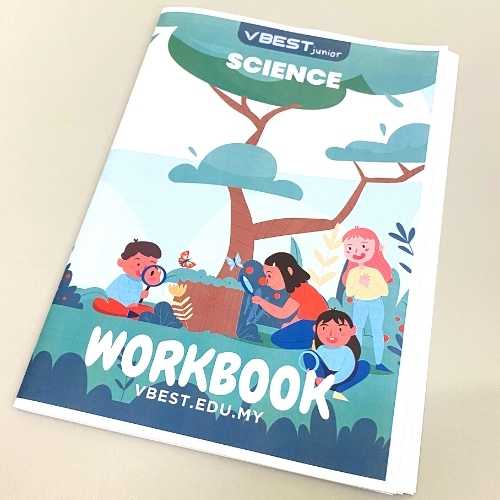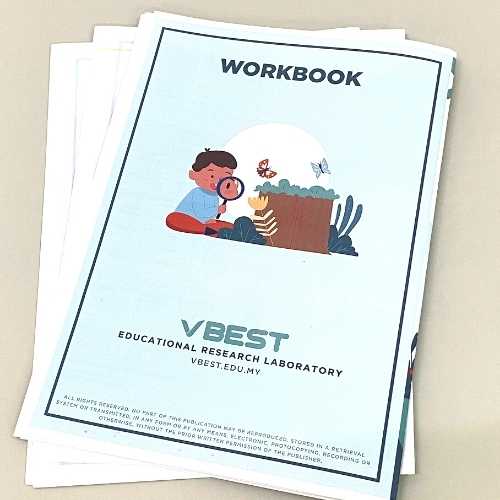
Cambridge Science Primary
VBest Cambridge Science Primary program offers classes for children between the ages of 3 to 13 years old.
Our program assists students in staying ahead of their peers in primary school.
Science Workbook



Course Details
Suitable for 4 years old kids.
- Phonics Song ( Animals & Body Parts )
- Flash Card Learning ( Animals & Body Parts)
- Learning Animals
- Exploring Body Parts
- Exploring Fruits & Vegetables
- Learning Weather Words
- Energy ( Sun & shade, hot & cold, heat, light & sound, people power vs fuel power )
- Forces And Movements ( Pushes & Pulls )
- Environment Resources
- Science Games ( Matching Games & Cardline Animals)
Suitable for 5 years old kids.
- Phonics Song ( Food, Fruits & Vegetables)
- Flash Card Learning (Food, Fruits & Vegetables)
- Exploring Type Of Animals ( Mammals, Amphibians, Birds, Fish, Reptiles, Minibeasts)
- Exploring Body Parts & Five Senses
- Exploring Food, Fruits & Vegetables ( Natural Food Chain & The Importance Of Plants As Energy)
- Types Of Weather
- Energy and Change ( Motion, Electricity )
- The Materials World ( Metals, Plastics & Matter )
- Resources ( Renewable & Non-renewable )
- Science Games ( Into The Forest )
Suitable for 6 years old kids.
- Phonics Song ( Planets)
- Flash Card Learning (Plantes)
- Exploring Acids And Alkalis
- Exploring Gravity
- Exploring Weather And Seasons
- Exploring Energy and Change ( Different Forms Of Energy, Electricity And Circuits )
- Exploring Cells And Human Reproduction
- Pollution
- Moon Phases
- Science Games (Xtronaut:)
Chapter 1 Animals
1.1 Structure of Common Animals
1.2 Common Animals
1.3 Asking and Answering Simple Questions
Chapter 2 Environment
2.1 Changes in the Four Seasons
Chapter 3 Grouping
3.1 Identifying and Classifying
Chapter 4 Human Body
4.1 Basic Parts of the Human Body 1
4.2 Basic Parts of the Human Body 2
Chapter 5 Materials
5.1 Everyday Materials
5.2 Physical Properties of Everyday Materials
5.3 Objects and Materials
5.4 Comparing Everyday Materials
Chapter 6 Plants
6.1 Basic Structure Plants and Trees
6.2 Common Plants and Trees
Chapter 7 Safety
7.1 Common Animals
Chapter 1 Animals
1.1 Offspring Through to Adults
1.2 Basic Survival Needs
Chapter 2 Habitats
2.1 Habitats and Micro-habitats
2.2 Habitat Needs
2.3 Animals Food and Food Chains
Chapter 3 Health
3.1 Basic Survival Needs
3.2 Importance of Exercise, Food and Hygiene
Chapter 4 Human Body
4.1 Importance of Exercise, Food and Hygiene
Chapter 5 Living Things
5.1 Things Living, Dead or Never Alive 1
5.2 Things Living, Dead or Never Alive 2
Chapter 6 Materials
6.1 Suitability for Purpose 1
6.1 Suitability for Purpose 2
6.3 Altering Shapes of Some Solids Objects
Chapter 7 Plants
7.1 Water, Light and Temperature for Growth
7.2 Seeds, Bulbs and Maturing Plants
Chapter 1 Push and Pulling
1.1 Push and Pulling
Chapter 2 Forces
2.1 Movement on Different Surfaces
2.2 Forces and Magnet
2.3 Which Force Do I Use?
Chapter 3 Human Body
3.1 Skeletons and Muscles 1
3.2 Skeletons and Muscles 2
3.3 Skeletons and Muscles 3
Chapter 4 Light
4.1 Changed in Shadows
4.2 Shadows
4.3 Light and Dark
Chapter 5 Magnets
5.1 Materials: Magnetic or Not?
5.2 Magnets Attract or Repel
5.3 Predicting Magnetism
Chapter 6 Nutrition
6.1 Nutrition
6.2 Animals, including Humans
Chapter 7 Plants
7.1 Life Cycle of Flowering Plants
7.2 Requirements for Life and Growth
7.3 Transporting Water in Plants
7.4 Functions of Parts of Flowering Plants
Chapter 8 Rocks
8.1 Different Type of Rocks
8.2 Soils
Chapter 1 Circuits
1.1 Simple Circuit
1.2 Conductors and Insulators
1.3 Lamps and Circuit
1.4 Switches
Chapter 2 Electricity
2.1 Common Electrical Appliance 1
2.2 Common Electrical Appliance 2
Chapter 3 Environment
3.1 Environment Change and Danger
Chapter 4 Food Chains
4.1 Animals, including Humans 1
4.2 Animals, including Humans 2
Chapter 5 Grouping
5.1 Living Things and Their Habitats 1
5.2 Living Things and Their Habitats 2
Chapter 6 Habitats
6.1 Classification and Environment 1
6.2 Classification and Environment 2
Chapter 7 Human Body
7.1 Basic Parts of Human Digestive System 1
7.2 Basic Parts of Human Digestive System 2
Chapter 8 Safety
8.1 Common Electrical Appliance
Chapter 9 Sound
9.1 How Sounds Travel
9.2 Pitch and Objects
9.3 Sounds and Vibration
Chapter 10 States Of Matter
10.1 Heating and Cooling
10.2 Solids, Liquids and Gases
Chapter 11 Teeth
11.1 Animals, including Humans 1
11.2 Animals, including Humans 2
Chapter 12 Water
12.1 Water Cycle: Evaporation and Condensation 1
12.2 Water Cycle: Evaporation and Condensation 2
Chapter 1 Changes in Materials
1.1 Non-reversible Changes
1.2 Reversible Changes
Chapter 2 Dissolving
2.1 Dissolving in Solution 1
2.2 Dissolving in Solution 2
Chapter 3 Forces
3.1 Resistance and Friction
3.2 Gravity
3.3 Reporting and Presenting Findings
Chapter 4 Gravity
4.1 Forces 1
4.2 Forces 2
Chapter 5 Living Things
5.1 Life Cycles
5.2 Reproduction: Plants and Animals 1
5.2 Reproduction: Plants and Animals 2
5.3 Reproduction: Plants and Animals 3
Chapter 6 Materials
6.1 Comparing and Grouping Properties of Materials
6.2 Testing Everyday Materials
Chapter 7 Mixtures
7.1 Separating Mixtures 1
7.2 Separating Mixtures 2
Chapter 8 Solar System
8.1 Our Sun as a Star, Other Starts and Galaxies
8.2 Sun, Earth and Moon
8.3 Movement of Earth and the Planets
8.4 Earth's Rotation: Day and Night
8.5 Movement of the Moon
Chapter 1 Circuit
1.1 Changing Wires Changing Circuits
1.2 A Torch and How it Works
1.3 Circuits Basics 1
1.4 Circuits Basics 2
1.5 Circuits Diagrams 1
1.6 Circuits Diagrams 2
1.7 Electrical Vocabulary Check-up
1.8 Investigating Materials Which Conduct Electricity
1.9 Wires and Components
Chapter 2 Classification
2.1 Animal Ears
2.2 Characteristics of Living Things
2.3 Keys
2.4 Differences Between Us
Chapter 3 Human Body
3.1 Skeleton and Circulation 1
3.2 Skeleton and Circulation 2
3.3 Skeleton and Circulation 3
Chapter 4 Light
4.1 Light and Shadows 1
4.2 Light and Shadows 2
4.3 Reflection 1
4.4 Reflection 2
Chapter 5 Living Things
5.1 How are Plants Adapted to Suit Their Environment?
5.2 Microbes and Cells
5.3 Food Chains
Things To Know | Frequently Asked Questions FAQs
How Long is the Duration for Each Lesson?
Each lesson will take from 60 minutes to 120 minutes depending on the subject and level.
How I know which class is suitable for my child?
We will provide assessment exam to test on their level before deciding which class they should attend.
Is this a private lesson?
Yes. It will be a 1 to 1 lesson. We can focus more on teaching each child.
What age group of children is suitable to attend VBest primary lesson?
We offers classes for children between the ages of 3 to 13 years old.
Will there be notes provided?
Yes, we will provide workbooks and notes for our students.
Book Class Now
We want your child to walk into a class that fits him and go to a teacher he likes to start his journey of academic excellence.
[contact-form-7 id="14196" title="Sign Up Form_2022"]
Our People